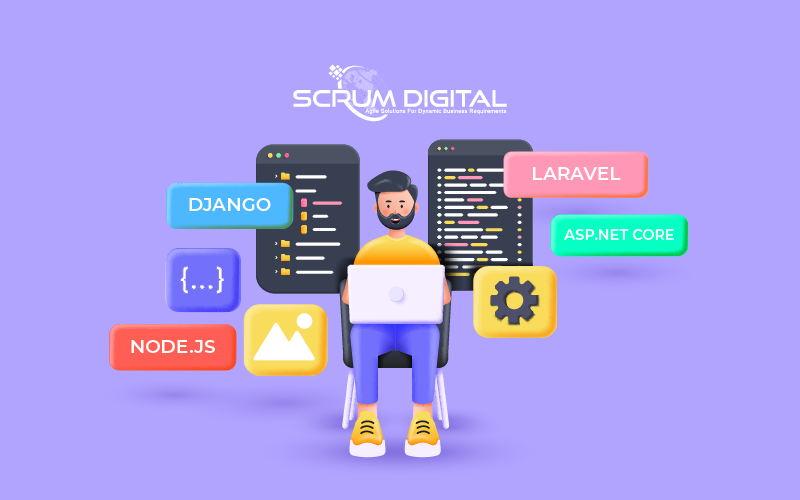In the current digital era, web development has become indispensable to any organization’s online presence.
The development of web applications requires a combination of front-end and back-end technologies to ensure a seamless user experience.
Regarding back-end web development, numerous frameworks are available, each with unique features and functionalities.
A back-end frameworks is a collection of libraries and tools to build server-side applications that communicate with databases, process data, and manage user sessions.
This blog will closely examine some of developers’ most popular and most used back-end frameworks worldwide.
We will explore the benefits and drawbacks of each framework and provide insights into which one might be the best fit for your next web development project.
So, sit back, relax, and explore the exciting world of back-end web development frameworks.
What are Back-end Frameworks?
Back-end frameworks refer to a collection of libraries, tools, and technologies used to build the server side of web applications.
The back end of a web application is responsible for processing data, managing user sessions, and communicating with databases. In contrast, the front end of a web application handles the user interface and user experience.
Back-end frameworks provide developers with a structure and set of tools to streamline the development process, allowing them to focus on the application’s core functionality rather than the low-level details of server-side programming.
These frameworks typically include database integration, user authentication, security mechanisms, and session management.
Benefits of Using a Back-end Frameworks

Using the best back-end framework for web development offers numerous benefits that can significantly streamline the development process and improve web applications’ performance, scalability, and security.
1. Accelerated Development Process
Back-end frameworks come with pre-built components and libraries that developers can leverage to speed up the development process.
These frameworks provide a structure and set of tools that enable developers to focus on the core functionality of the web application rather than worrying about low-level details of server-side programming. This results in faster development and faster time-to-market for the web application.
2. Improved Scalability
Back-end frameworks offer scalability features that enable web applications to handle increasing users and traffic.
These frameworks are designed to handle heavy loads and can automatically scale up or down based on demand. This ensures that web applications can handle traffic spikes and grow with the business needs.
3. Increased Security
Back-end frameworks provide security mechanisms such as authentication, authorization, and encryption to protect web applications from malicious attacks.
These frameworks are designed to implement security best practices and reduce the risk of security breaches. This is critical, especially for applications that handle sensitive data.
4. Better Code Quality
Back-end frameworks follow best practices and coding standards that ensure a consistent and high-quality codebase.
This results in cleaner, more maintainable code that is easier to read and debug. Additionally, frameworks often come with built-in testing and debugging tools that enable developers to catch errors early and reduce the risk of bugs in the production environment.
5. Community Support
Back-end frameworks have large and active communities that provide support, documentation, and open-source libraries.
This means that developers can leverage the expertise of other developers and access a wealth of resources to help them solve problems and improve their code.
Types of Back-end Frameworks
When examining the various top back-end frameworks, businesses need to recognize that they can be broadly categorized into two types:
1. Client-side web frameworks
These frameworks exclusively focus on the user interface, emphasizing the user’s experience and the application’s usability.
2. Server-side web frameworks
This type of framework is primarily used for back-end operations, including managing the web server, manipulating databases, and performing various data-related tasks, among others.
Most Popular Back-end Frameworks for 2025
1. Node.js
Node.js is an open-source, cross-platform JavaScript runtime environment built on Google’s V8 engine. It is widely used for developing scalable and high-performance network applications, particularly in real-time applications like chat apps and game development.
It offers a vast collection of pre-built modules, making it easy for developers to build and deploy applications quickly.

Pros:
- High performance and scalable due to asynchronous event-driven architecture
- Large community support and resources available
- JavaScript as the primary language makes it easy for web developers to learn and adopt
- It can be used for both server-side and client-side development
Cons:
- Callback-based programming model can lead to complex and hard-to-read code
- Lack of strong typing can make it harder to maintain large codebases
- Not suitable for CPU-intensive tasks due to the single-threaded nature
2. Django
Django is a high-level, open-source Python web framework that follows the Model-View-Controller (MVC) architectural pattern.
It is widely used for building web applications that require fast development, security, and scalability.
Django provides a range of features, including built-in administration panels, a robust ORM system, and a flexible URL routing system.

Pros
- Highly productive due to built-in admin interface and powerful ORM
- Strong security features and built-in support for authentication and authorization
- Large community support and resources available
- Python as the primary language makes it easy for developers to learn and adopt
Cons
- Not as performant as some other frameworks due to the heavy use of Python
- The steep learning curve for developers who are not familiar with Python or Django ecosystem
- Limited flexibility compared to other frameworks
3. Ruby on Rails
Ruby on Rails is an open-source web application framework in the Ruby programming language. It follows the Model-View-Controller (MVC) architectural pattern and provides a range of features, including a built-in ORM system, a testing framework, and a modular design.
Ruby on Rails is widely used for developing scalable and maintainable web applications.

Pros
- Highly productive due to the “convention over configuration” approach and powerful ORM
- Large community support and resources available
- Ruby, as the primary language, makes it easy for developers to learn and adopt
- Strong focus on testing and quality assurance
Cons
- It can be slow and memory-intensive due to the heavy use of Ruby
- The steep learning curve for developers who are not familiar with the Ruby or Rails ecosystem
- Limited flexibility compared to other frameworks
4. Flask
Flask is a micro-framework written in Python and designed for quickly building small web applications. Flask provides a range of features, including easy-to-use routing, support for extensions, and a lightweight design. It is widely used to develop web applications requiring a simple and efficient framework.

Pros
- Lightweight and flexible, allowing for greater customization and control over the code
- Large community support and resources available
- Python as the primary language makes it easy for developers to learn and adopt
- Good for small to medium-sized projects
Cons
- Less built-in functionality compared to other frameworks like Django
- Not as productive as some other frameworks due to the need for more manual setup and configuration
- Limited scalability compared to other frameworks
5. Laravel
Laravel is an open-source PHP web application framework that follows the Model-View-Controller (MVC) architectural pattern.
It provides a range of features, including a built-in ORM system, a modular design, and a powerful templating engine. Laravel is widely used for developing scalable and maintainable web applications.

Pros:
- Highly productive due to built-in features like Artisan and Eloquent ORM
- Large community support and resources available
- PHP as the primary language makes it easy for developers to learn and adopt
- Good for small to medium-sized projects
Cons:
- It can be slower compared to some other frameworks due to the heavy use of PHP
- The steep learning curve for developers who are not familiar with PHP or Laravel ecosystem
- Limited flexibility compared to other frameworks.
6. ASP.NET Core
ASP.NET Core is an open-source popular backend framework that is cross-platform and designed for developing applications using .
NET. This framework provides a lightweight implementation of the Microsoft server stack, enabling developers to create and run applications in various environments and platforms.
It supports many programming languages, including C#, F#, Visual Basic, NodeJS, and JavaScript, and is suitable for building web apps and API servers.

Pros:
- Cross-platform development support
- Strong security features and built-in support for authentication and authorization
- High performance due to features like native memory management and Just-In-Time compilation
- Integration with Microsoft tools and services like Azure, Visual Studio, and SQL Server
Cons:
- The steep learning curve for developers who are not familiar with C# or the .NET ecosystem
- More verbose compared to other frameworks
- Limited community support and resources compared to other popular frameworks like Node.js or Django
7. Spring Framework
Spring Framework is an open-source Java-based application framework designed to support the development of enterprise-level applications.
It provides a comprehensive programming and configuration model for modern Java-based enterprise applications.
It simplifies development by providing a robust, flexible, and scalable infrastructure to build, test and deploy enterprise applications.
The Spring Framework is designed to be modular, with each module providing different features that can be used independently or in combination with other modules.

Pros
- Spring follows a modular architecture, which makes it easy to add or remove components per the application’s requirements.
- Its dependency injection feature enables the creation of loosely coupled applications, meaning the code can be more easily maintained and tested.
- It is lightweight and doesn’t require any heavy server or runtime environment.
Cons
- The steep learning curve for developers who are not proficient in using Spring.
- Spring adds some performance overhead, especially for small applications, which may not be suitable for some projects.
- It has compatibility issues, which can cause problems during development and deployment.
Conclusion
Most of these frameworks provide excellent functionality and capabilities for developing your project due to their construction using established programming languages.
The most suitable server environment for your project will depend on its particular requirements, and the choice of which server framework to implement ultimately rests with you.
At Scrum Digital, we understand the importance of selecting the right back-end framework for your web development needs.
Our team of experienced developers has the expertise to help you navigate the various frameworks and choose the one that best backend frameworks your project requirements. Contact us today to learn more about our services and how we can help you achieve your goals.


